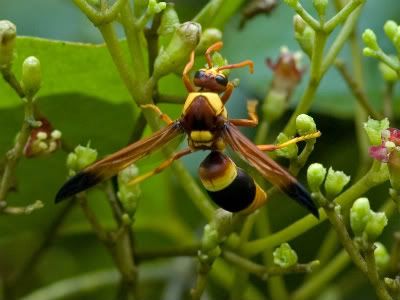
For Azudo, I hope this clears something up.
I had come across the same article I had linked to on this entry which is broken now so I found it again (they must've moved the article at some point) and did a brief read through of it. The article mentions that the entire genus of Abispa (6 species total) is restricted to Australia and New Guinea.
Said article that mentions this is here. The article article also mentions another wasp Pseudabispa paragioides that they:
In morphology, coloration, and size, Pseudabispa wasps (Hymenoptera: Vespidae: Eumeninae) closely resemble mason wasps in the genus Abispa, and their distributions overlap. Although these two genera are among the largest solitary wasps in Australia, the biology of Pseudabispa was not previously known. Field observations from near Katherine, Northern Territory, strongly suggest that P. paragioides (Meade-Waldo) females attack and kill female A. ephippium (Fabricius) and usurp their nests, then appropriate cells, mass provision them with caterpillars acquired by theft from still other nests, and close them with mud taken from the host nest.
Taken from here when a brief "Google raid" was done on them for information also. I will do even more research on these (because they're both fascinating as hell) and give both articles a proper read through at a saner time (It's 1:30AM as I type this).
Apparently Pseudabispa paragioides also occurs in Australia and overlaps with A. ephippium. So Azudo it is possible that you also might be seeing P. paragioides. Idk I would need a picture. To quote you:
"So where did you find this info. i,ve been researching these creatures for days now and i can't find much on them. the reason is that these creatures are not supposed to live in southern vistoria yet i have one nesting in my front yard and she 's about 3 inches long. any info would be appreciated"
-Azudo
What makes you think that these (Abispa ephippium) are not "supposed" to occur where you live? Is there a reference that also mentions them not occuring there?
Southern Victoria is in Australia. Nothing I have found mentions them not being there. They just mention both Abispa and Pseudabispa occurring in Australia and that Pseudabispa will overlap with Abispa. So far I have seen nothing mentioning exactly where in Australia these wasp occur.
Will need more info and if possible anything you've found during your three days of research. =)

Pseudabispa paragioides (top) and Abispa ephippium They look so much alike except for coloring and size. Startling that P. paragioides goes only for A. ephippium nests exclusively.....
Photo is from the first article. This is used elsewhere too. Don't blame them. It's impressive. Apparently (according to the first article I linked to) the A. ephippium being attacked by The Evil Twin (as I'm now calling P. paragioides) died shortly after.
Poor baby......=(

Pseudabispa paragioides
Will read about these more in depth later. Must get some rest. I hope that this has helped somewhat. I'll try and see if I can pinpoint exactly where in Australia both of these wasps naturally occur and if they're prone to stray.
Could use more of your in point on this too if you don't mind. =)
1 comment:
interresting informations
Post a Comment